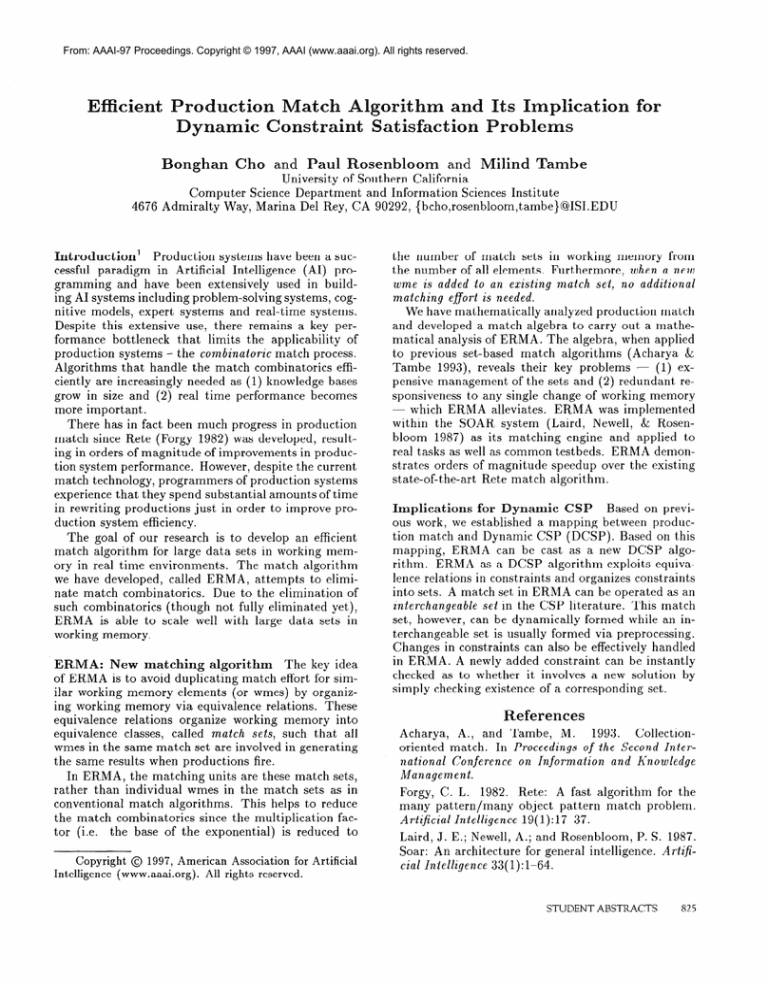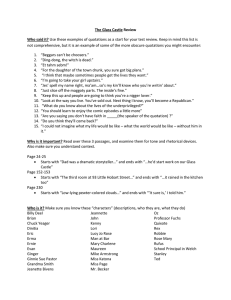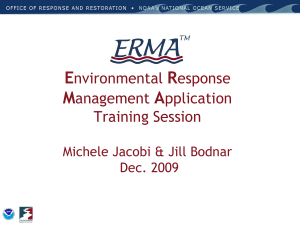
From: AAAI-97 Proceedings. Copyright © 1997, AAAI (www.aaai.org). All rights reserved.
cient Production
Mate
ynamic Constr
Bonghan
Cho
and Paul Rosenbloom
and Milind
Tambe
University of Southern California
Computer Science Department
and Information
Sciences Institute
4676 Admiralty Way, Marina Del Rey, CA 90292, {bcho,rosenbloom,tambe}@ISI.EDU
Introduction1
Production
systems have been a successful paradigm
in Artificial
Intelligence
(AI) programming
and have been extensively
used in building AI systems including problem-solving
systems, cognitive models, expert systems and real-time systems.
Despite this extensive use, there remains a key performance
bottleneck
that limits the applicability
of
production systems - the combinatoric
match process.
Algorithms
that handle the match combinatorics
efficiently are increasingly
needed as (1) knowledge bases
grow in size and (2) real time performance
becomes
more import ant.
There has in fact been much progress in production
match since Rete (Forgy 1982) was developed, resulting in orders of magnitude of improvements
in production system performance.
However, despite the current
match technology, programmers
of production systems
experience that they spend substantial amounts of time
in rewriting productions just in order to improve production system efficiency.
The goal of our research is to develop an efficient
match algorithm for large data sets in working memory in real time environments.
The match algorithm
we have developed, called ERMA, attempts
to eliminate match combinatorics.
Due to the elimination
of
such combinatorics
(though not fully eliminated yet),
ERMA is able to scale well with large data sets in
working memory.
ERMA:
New matching
algorithm
The key idea
of ERMA is to avoid duplicating match effort for similar working memory elements (or wmes) by organizing working memory via equivalence relations.
These
equivalence
relations
organize working memory into
equivalence
classes, called match
sets, such that all
wmes in the same match set are involved in generating
the same results when productions
fire.
In ERMA, the matching units are these match sets,
rather than individual wmes in the match sets as in
conventional
match algorithms.
This helps to reduce
the match combinatorics
since the multiplication
factor (i.e.
the base of the exponential)
is reduced to
Copyright
@ 1997, American
Association
for Artificial
Intelligence
(www.aaai.org).
All rights reserved.
the number of match sets in working memory from
the number of all elements. Furthermore,
when a new
wme is added to an existing match set, no additional
matching
eflort is needed.
We have mathematically
analyzed production match
and developed a match algebra to carry out a mathematical analysis of ERMA. The algebra, when applied
to previous set-based
match algorithms
(Acharya
&
Tambe 1993), reveals their key problems (1) expensive management of the sets and (2) redundant responsiveness to any single change of working memory
- which ERMA alleviates.
ERMA was implemented
within the SOAR system (Laird,
Newell, & Rosenengine and applied to
bloom 1987) as its matching
real tasks as well as common testbeds.
ERMA demonstrates orders of magnitude speedup over the existing
state-of-the-art
Rete match algorithm.
Implications
for Dynamic
CSP
Based on previous work, we established
a mapping between production match and Dynamic CSP (DCSP).
Based on this
mapping,
ERMA can be cast as a new DCSP algorithm.
ERMA as a DCSP algorithm exploits equivalence relations in constraints and organizes constraints
into sets. A match set in ERMA can be operated as an
interchangeable
set in the CSP literature.
This match
set, however, can be dynamically
formed while an interchangeable
set is usually formed via preprocessing.
Changes in constraints
can also be effectively handled
in ERMA. A newly added constraint
can be instantly
checked as to whether it involves a new solution by
simply checking existence of a corresponding
set.
References
Acharya,
A., and Tambe,
M.
1993.
Collectionoriented match.
In Proceedings
of th,e Second International
Conference
on Information
and Knowledge
Management.
Forgy, C. L. 1982.
many pattern/many
Artificial
Intelligence
Rete:
A fast algorithm for the
object pattern match problem.
19( l):l’i-37.
Laird, J. E.; Newell, A.; and Rosenbloom,
P. S. 1987.
Soar: An architecture
for general intelligence.
Artificial Intelligence
33( l):l-64.
STUDENT ABSTRACTS
825






